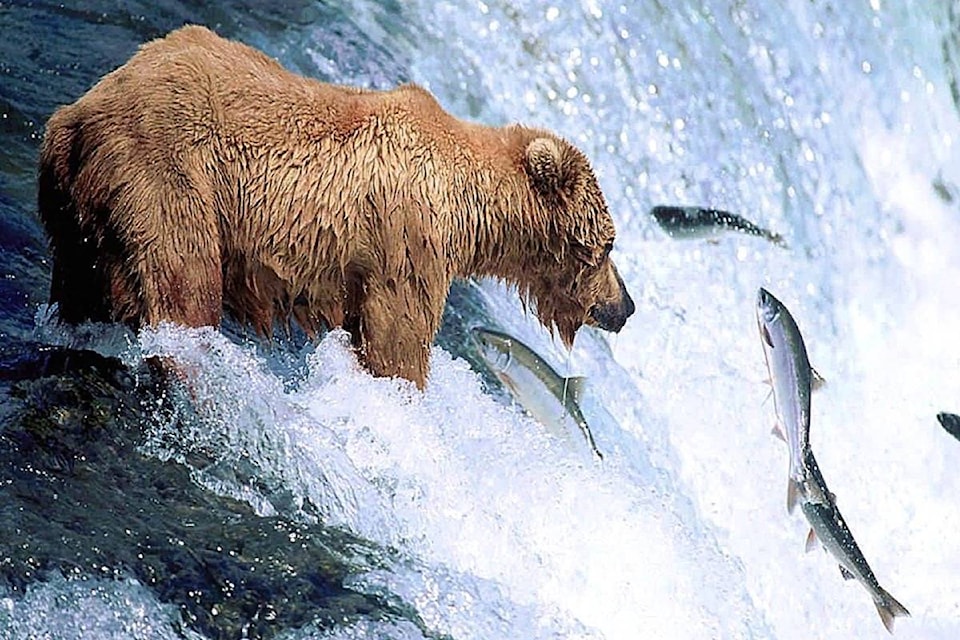The NDP government has put a stop to the hunting of grizzly bears throughout the province, but not everyone is happy with the move.
The decision was announced on Dec. 18, 2017 by Forests, Lands, Natural Resource Operations and Rural Development (FLNRORD) Minister Doug Donaldson and Environment and Climate Change Strategy (ECCS) Minister George Heyman.
The order went into effect immediately for resident and non-resident hunters, cancelling the previous scheduled open of grizzly bear hunting set to be in effect April 1, 2018.
After a consultation process with First Nations, stakeholder groups and the public, a sizable 78 per cent of respondents agreed the ban should be put placed, according to the government press release.
Donaldson stated the government listened to what British Columbians had to say on this issue, and “it is abundantly clear the grizzly hunt is not in line with their values.”
There are an estimated 15,000 grizzly bears in B.C., according to the release.
“We also want to promote the healthy grizzly bear viewing economy in B.C.,” Heyman stated, “and give everyone the tremendous opportunity to see these incredible animals in their natural habitat.”
The ban on trophy hunting of grizzly bears was also announced August 2017, and became effective Nov. 30, 2017. At that time, the government also put a stop to all hunting of grizzly bears in the Great Bear Rainforest.
According to The Wilderness Tourism Association, the ban is believed to increase the benefits to the economy through a greater influx of adventure tourism to the area, bringing in an estimated $1.5 billion.
The harvesting of grizzly bears by First Nations is excluded from the ban with respect to the Aboriginal rights for food, social, or ceremonial purposes or treaty rights.
The amount of grizzly bears killed by non-First Nations hunters significantly outnumbers the amounts harvested for the purposes of these Aboriginal rights, according to the government.
The government issued around 1,700 grizzly bear permits in 2017, and around 250 of the 300 bears killed annually are by non-First Nation hunters.
Nazko First Nation Chief Stuart Alec says he feels the ban will be a crucial element in the conservation of the grizzly bear population of B.C.
“It’s so much better for the grizzly population overall.
“It seems hunters nowadays use the hunt more for the sake of a talking piece back in the office. It’s more like a sport used for bragging rights.”
Alec notes that all parts of the animal are most often not utilized in this type of sport hunting, and is, in turn, a tragic waste of an already declining species.
The Nazko chief adds there isn’t a lot of grizzly bears in the Cariboo region due to the low salmon returns in the area.
Many grizzlies have migrated to the south and east where the salmon run has been less affected, he adds.
Meanwhile, local guides and outfitters in the area have a different opinion on the ban, with a strong argument that it will, in fact, put grizzly bears in danger.
Many hunters and hunting groups say they believe crucial scientific findings were actually disregarded in the decision-making process.
Stewart Fraser, owner of the Itcha Mountain Outfitters in the Nazko area, says the ban is strictly a political move and that the decision wasn’t based on the scientific facts, which supports the argument that hunting keeps the grizzly population safe and controlled.
Fraser adds he feels the hunt is a carefully monitored management tool that will mitigate human-bear conflicts and minimize the threat of male grizzlies attacking grizzly cubs.
He explains that bears learn quickly, and will begin encroaching into human territory more often. Once they learn humans pose less of a threat, they will begin to feel more confident and move in closer to areas populated by humans.
“More bears are going to die. The older the boars get, the more [cubs] they’ll kill. They’ll kill a sow’s cub, so they can push [them] back into heat so they can breed.”
Many outfitters say they believe that after extensive research, it isn’t hunting that poses the biggest threat to grizzly bears. It’s the species’ loss of habitat that should be the target issue.
Brad Bowden, of Cariboo Mountain Outfitters, is a second-generation outfitter, and has been guiding for 41 years.
He says ignoring the extensive studies and the science that supports hunting poses a large threat to wildlife as a whole.
“Grizzlies are growing in numbers. They are not threatened or endangered.
“Hunters harvest less than two per cent of the total grizzly population…. Decisions being made from the urban centres in the Lower Mainland that have no clue of what goes on in the wild.
“You cannot close one species [the grizzly] without a cost to the ungulate population. We must manage wildlife using science for future generations to enjoy.”
Those who oppose the decision say the ban greatly affects the hunting and outfitting industry, which brings in approximately $370 million per year toward the B.C. economy.
This does not include the major hit to the livelihood of the families who rely on the income per year, Bowden says.
“The decision has cost my operation 15 per cent of my yearly income. The spin-offs will affect the economy of our town and my employees.”
